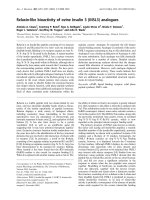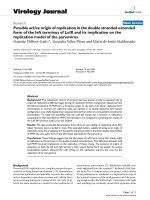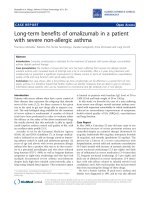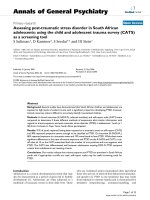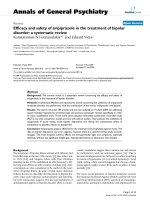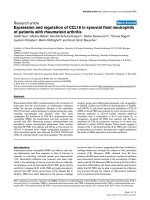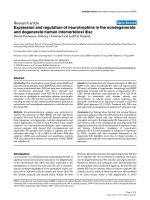Báo cáo y học: "Assessing the origin of species in the genomic era" doc
Bạn đang xem bản rút gọn của tài liệu. Xem và tải ngay bản đầy đủ của tài liệu tại đây (74.26 KB, 4 trang )
Genome Biology 2005, 6:217
comment
reviews
reports deposited research
interactions
information
refereed research
Minireview
Assessing the origin of species in the genomic era
Leonie C Moyle
Addresses: Center for Population Biology, 2320 Storer Hall, University of California, Davis, CA 95616, USA. E-mail:
Current address: Department of Biology, 1001 East Third Street, Indiana University, Bloomington, IN 47405, USA.
E-mail:
Abstract
Advances in genomics have rapidly accelerated research into the genetics of species differences,
reproductive isolating barriers, and hybrid incompatibility. Recent genomic analyses in Drosophila
species suggest that modified olfactory cues are involved in discrimination that is reinforced by
natural selection.
Published: 31 March 2005
Genome Biology 2005, 6:217 (doi:10.1186/gb-2005-6-4-217)
The electronic version of this article is the complete one and can be
found online at />© 2005 BioMed Central Ltd
Ever since Darwin laid out overwhelming evidence for the
mutability of species, biologists have sought to explain the
forces driving the genesis of new species and the genetic
changes involved in speciation. Frequently, this goal has been
translated into the study of the genetic basis of species differ-
ences, especially the genetic causes of inviability or sterility in
hybrids between species. Despite creative early approaches to
these problems [1], however, classical genetic studies pro-
vided insufficient resolution for identifying the specific
genomic regions and genes responsible for these traits. It is
unsurprising, then, that the field of speciation genetics is
being revolutionized by the rapidly expanding availability of
genomic tools, techniques, and data, especially in the model
speciation systems such as Drosophila. The resulting con-
temporary studies of the genetics of speciation most fre-
quently involve detailed linkage-mapping analyses of the
quantitative trait loci (QTLs) underlying the isolating barriers
and hybrid incompatibility between closely related species.
The genomics of species divergence and hybrid
incompatibility
By far the most likely, and most explicable, form of specia-
tion occurs when populations diverge from each other while
separated by an external barrier to gene flow, such as simple
physical distance. Genetic changes can accumulate in these
isolated populations, either in response to different environ-
mental pressures or purely through random sampling
processes (genetic drift). As a consequence, when diverged
populations are brought back into contact, exchange of
genes between them is restricted; for example, diverged
mating signals may prevent hybridization, or hybrids may be
unfit either because of inappropriate genic interactions or
because they are phenotypically intermediate and thus ill-
suited to either parental environment. Most of the recent
QTL mapping approaches have examined species differences
and hybrid incompatibility in the context of this model of
‘allopatric’ speciation (speciation during physical isolation in
the absence of gene flow). The most detailed studies have
focused on identifying the number, genomic location, and
distribution of individual effects of QTLs underlying hybrid
male and female sterility among Drosophila species [2,3]. So
far, the results indicate a number of general patterns in the
genetics of Drosophila hybrid incompatibility; for example,
incompatibility is frequently highly polygenic and epistati-
cally complex, and within any specific cross many more loci
confer hybrid male sterility than confer female sterility or
hybrid inviability [2-6].
Hot on the heels of these landmark Drosophila studies are a
suite of related analyses of speciation in a newer but increas-
ingly developed wave of model systems, including sunflower
[7], monkeyflower (Mimulus) [8,9], mosquito [10], and
tomato [11]. With the inclusion of these new systems, evolu-
tionary geneticists are beginning to piece together a general
understanding of the genetic architecture of speciation, as
well as the biological factors that might contribute to the
differences observed between phylogenetically divergent
groups [11]. In addition to expanding the phylogenetic scope
of speciation genetics, the increasing availability of genomic
tools is also enabling the dissection of more complex modes
of speciation. One recent study is that of Ortiz-Barrientos
and colleagues published in PLoS Biology [12]; they examine
the genetics of speciation by reinforcement - one of the most
attractive but controversial models of speciation.
The genetics of speciation by reinforcement
Speciation by reinforcement has long held biologists’ atten-
tion because it unites two classical evolutionary processes:
speciation and natural selection. During allopatric specia-
tion, natural selection can play only an indirect role in the
evolution of reproductive barriers, by bringing about trait
changes that inadvertently prevent gene flow between
diverging populations. Under reinforcement, however,
natural selection directly favors the evolution of barriers to
mating between incipient species. The most straightforward
conceptual model of this process imagines two species (or
highly diverged populations) that have accumulated some
degree of genetic incompatibility (in isolation or allopatry),
such that hybrids between them have reduced fitness.
Nonetheless, because genetic differentiation between the
groups is incomplete, when they co-occur in the same geo-
graphical location (that is, they are in ‘sympatry’), less fit
hybrids can be formed. In this case, any individuals that
preferentially mate with only their own kind will have a
selective advantage because they do not waste any reproduc-
tive effort on producing sterile hybrid offspring. In regions of
geographical overlap, natural selection will thus act directly
to ‘reinforce’ the partial isolation between two groups by
favoring traits that reduce inter-type matings. Although the
frequency of speciation by reinforcement (especially in com-
parison with simple allopatric speciation) continues to be
debated, it now seems clear that there is solid theoretical
support for this mode of speciation, as well as empirical
support in a few well described cases [13].
Ortiz-Barrientos and colleagues [12] have examined the
genetics of mate discrimination in one such probable case of
reinforcement between two very closely related fruit-fly
species. Drosophila pseudoobscura and D. persimilis co-
occur in coastal northwestern USA, but D. pseudoobscura is
also found alone throughout a large proportion of its natural
range. In artificial mating trials between the two species,
D. pseudoobscura females from allopatric populations show
weak mating discrimination against D. persimilis males
(described as ‘basal’ mate discrimination), whereas females
from sympatric populations show enhanced mating discrim-
ination (described as ‘reinforced’ mate discrimination) [14].
This pattern is consistent with the operation of reinforce-
ment, as selection is expected directly to favor strong mating
discrimination in sympatry only: no hybrids can be pro-
duced in allopatry, so there is no direct selective pressure for
increased mate discrimination in allopatric populations.
Ortiz-Barrientos and colleagues confirmed these mate-
discrimination patterns and went on, in a series of back-
crosses, hybrid mating trials, and QTL mapping analyses, to
identify the genomic locations of traits that are responsible
for the reinforced mate discrimination of D. pseudoobscura
against D. persimilis. Their analysis is particularly novel in
that it capitalizes on within-species variation in mating
propensity in order to understand the genetic basis of trait
changes involved in reinforcement between species. To do
so, the general strategy was to cross allopatric to sympatric
populations within D. pseudoobscura and then to mate the
resulting hybrid females with D. persimilis to assess their
level of mating discrimination (Figure 1). This allowed
Ortiz-Barrientos et al. [12] to map the QTLs associated with
reinforced mate discrimination against D. persimilis: using
two separate sympatric-allopatric population pairs of
D. pseudoobscura derived from four different locations,
they first analyzed whole-chromosome effects on mating
discrimination by backcrossing to F1 males (there is no
meiotic recombination in Drosophila males so chromo-
somes are inherited as unrecombined blocks in this case).
They showed that whole-chromosome effects differ between
different allopatric-sympatric population pairs, suggesting
that there is a different genetic basis for reinforced mate
discrimination against D. persimilis in the two different
sympatric D. pseudoobscura locations examined. Second,
using a recombinant backcross population (BC1) derived
from a single D. pseudoobscura allopatric-sympatric com-
bination, they localized two strongly supported and two
probable QTLs to regions on chromosome 4 and the
217.2 Genome Biology 2005, Volume 6, Issue 4, Article 217 Moyle />Genome Biology 2005, 6:217
Figure 1
A generalized scheme of the crossing procedure used by Ortiz-Barrientos
et al. [12] to analyze mating discrimination against D. persimilis by
D. pseudoobscura females in sympatric populations. Sympatric and
allopatric populations of D. pseudoobscura, differing in their levels of
mating discrimination against D. persimilis, were crossed to produce F1
hybrids, which were then backcrossed to the same allopatric population
to produce BC1 flies with segregating variation in mating-discrimination
traits. BC1 females were tested in mating trials with D. persimilis to assess
the degree of mating discrimination. Females were then genotyped at 70
markers distributed throughout the genome in order to map sympatric
mating-discrimination loci.
X
D. pseudoobscura
(allopatric)
D. pseudoobscura
(sympatric)
D. pseudoobscura
(allopatric)
BC1
Females used in
mating trials with
D. persimilis
X
F1
X chromosome, respectively, using standard QTL mapping.
Finally, by consulting the recently sequenced D. pseudoob-
scura genome, as well as functional genomic information
from D. melanogaster, the researchers identified likely can-
didate loci that lie within the mapped chromosomal
regions. These include two loci (bru-3 and CG13982) whose
mutation with P-elements leads to smell impairment, as
well as several UTP-glycosyltransferases that encode
enzymes involved in detoxification and olfaction. Although
these candidate genes are necessarily tentative until the
requisite functional assays are performed, the results impli-
cate olfactory changes as important factors in female
mating discrimination under reinforcement.
In the light of prior studies, several substantive conclusions
follow from this novel combination of analyses. First, the
QTLs underlying reinforced mate discrimination clearly
differ from those previously identified as underlying the
basal isolation that separates all D. pseudoobscura and
D. persimilis populations. This basal isolation, expressed as
weaker female mate discrimination, was previously mapped
to two inverted regions on chromosome 2 and the X chromo-
some [15]. Along with other studies [16], this finding ignited
the recent interest in models of speciation involving regions
of substantially reduced recombination such as chromoso-
mal inversions. In the new study, however, there is no evi-
dence for the role of inversions in reinforced mate
discrimination, suggesting that very different genetic mecha-
nisms underlie this second layer of isolation between
species. The evidence that the genetic basis of mate discrimi-
nation differs even among different sympatric populations
within D. pseudoobscura also emphasizes the fact that dif-
ferent genetic systems may be recruited during the evolution
of reproductive barriers. The second major conclusion is that
different mate-signaling modalities appear to be involved in
reinforced versus basal layers of reproductive isolation.
Basal isolation is thought to be due to changes in auditory
cues during mating [15], whereas reinforced mate discrimi-
nation probably involves modified olfactory signals between
sympatric D. pseudoobscura and D. persimilis [12].
Many genetic paths to speciation
In combination, these two substantive conclusions support
the intuition of many biologists that overall reproductive
isolation between species is likely to be due to the com-
bined effect of numerous different trait changes. Nonethe-
less, whether the particular genetic mechanisms or kinds of
traits involved in speciation differ systematically between
phylogenetic groups, or between different stages of repro-
ductive isolation, remains to be clarified in future studies on
other complementary systems. It is reasonable to expect, for
example, that pre-mating barriers to interspecific gene flow
will frequently involve trait changes that are directly con-
nected with mating or reproductive interactions. In the case
of D. pseudoobscura and D. persimilis, these traits are
both the olfactory and the auditory factors that presumably
affect perception of potential mating partners. In compari-
son, mating isolation between adjacent monkeyflower
species involves changes in floral traits that influence the
attractiveness of flowers to pollinators, and thus reduce
interspecific pollinations [8]; much of this variation in pol-
linator visitation is associated with loci that control flower
coloration [9]. In both cases, although the specific trait
changes are quite different, they have straightforward bio-
logical links to their corresponding species barriers. In
contrast, it seems less certain that the genetic underpin-
nings of hybrid inviability and sterility will be biologically
unified or predictable. Indeed, in the handful of cases in
which researchers have identified individual genes that
confer hybrid inviability or sterility [17-19], there is little
indication that particular classes or kinds of genes are rou-
tinely involved in hybrid incompatibility, although all such
loci do appear to be rapidly evolving. Other evidence simi-
larly suggests that the genetic complexity of speciation
traits might also differ systematically between different
stages of reproductive isolation [15] or among different
biological systems [11].
Finally, beyond enhancing our understanding of the
details of reinforcement, the work of Ortiz-Barrientos and
colleagues [12] also clearly illustrates how genetic studies
of speciation can be facilitated by additional (seemingly
unrelated) paths of genomic research. In particular, the
authors use prior functional analyses (specifically in
mutant lines) of D. melanogaster to generate hypotheses
about the functional role of genes falling within the identi-
fied QTL regions. Functional genomic parallels can also be
drawn constructively across more distant phylogenetic
connections. In a recent analysis, An et al. [20] used circa-
dian pathways described in D. melanogaster to generate
and test hypotheses about the role of altered gene expres-
sion in mating isolation among two sympatric tephritid
fruit flies. Using a combination of gene-expression assays
and artificial mating experiments, they found evidence
that changes in the circadian cycling of the cryptochrome
gene - a light-sensitive component of the circadian clock -
was associated with shifts in the timing of diurnal mating
between species. Changed gene expression was specifically
localized to the antennal lobe within the brain [20], again
implicating a role for altered olfactory processes in the
development of mating isolation. It is through careful
studies such as these - which include creative and judi-
cious use of genomic information developed in other con-
texts - that evolutionary biologists can continue to make
such great strides in understanding the genetic basis of,
and evolutionary forces involved in, the generation of bio-
diversity through speciation.
Acknowledgements
This work was supported by a CPB Postdoctoral Research Fellowship. M.
Hahn provided useful comments and advice.
comment
reviews
reports deposited research
interactions
information
refereed research
Genome Biology 2005, Volume 6, Issue 4, Article 217 Moyle 217.3
Genome Biology 2005, 6:217
References
1. Dobzhansky T: Studies on hybrid sterility II. Localization of
sterility factors in Drosophila pseudoobscura hybrids. Genetics
1936, 21:113-135.
2. Tao Y, Chen SN, Hartl DL, Laurie CC: Genetic dissection of
hybrid incompatibilities between Drosophila simulans and
D. mauritiana. I. Differential accumulation of hybrid male
sterility effects on the X and autosomes. Genetics 2003,
164:1383-1397.
3. Tao Y, Zeng ZB, Li J, Hartl DL, Laurie CC: Genetic dissection of
hybrid incompatibilities between Drosophila simulans and
D. mauritiana. II. Mapping hybrid male sterility loci on the
third chromosome. Genetics 2003, 164:1399-1418.
4. Hollocher H, Wu CI: The genetics of reproductive isolation in
the Drosophila simulans clade: X vs autosomal effects and
male vs female effects. Genetics 1996, 143:1243-1255.
5. True JR, Weir BS, Laurie CC: A genome-wide survey of hybrid
incompatibility factors by the introgression of marked seg-
ments of Drosophila mauritiana chromosomes into
Drosophila simulans. Genetics 1996, 142:819-837.
6. Presgraves DC: A fine-scale genetic analysis of hybrid incom-
patibilities in Drosophila. Genetics 2003, 163:955-972.
7. Rieseberg LH, Whitton J, Gardner K: Hybrid zones and the
genetic architecture of a barrier to gene flow between two
sunflower species. Genetics 1999, 152:713-727.
8. Bradshaw HD, Wilbert SM, Otto KG, Schemske DW: Genetic
mapping of floral traits associated with reproductive isola-
tion in monkeyflowers (Mimulus). Nature 1995, 376:762-765.
9. Bradshaw HD, Schemske DW: Allele substitution at a flower
colour locus produces a pollinator shift in monkeyflowers.
Nature 2003, 426:176-178.
10. Slotman M, della Torre A, Powell JR: The genetics of inviability
and male sterility in hybrids between Anopheles gambiae and
Anopheles arabiensis. Genetics 2004, 167:275-287.
11. Moyle LC, Graham EB: Genetics of hybrid incompatibility
between Lycopersicon esculentum and L. hirsutum. Genetics
2005, 169:355-373.
12. Ortiz-Barrientos D, Counterman BA, Noor MAF: The genetics of
speciation by reinforcement. PLoS Biol 2004, 2:2256-2263.
13. Servedio MR, Noor MAF: The role of reinforcement in specia-
tion: theory and data. Annu Rev Ecol Evol Syst 2003, 34:339-364.
14. Noor MAF: Speciation driven by natural selection in
Drosophila. Nature 1995, 375:674-675.
15. Noor MAF, Grams KL, Bertucci LA, Reiland J: Chromosomal
inversions and the reproductive isolation of species. Proc Nat
Acad Sci USA 2001, 98:12084-12088.
16. Rieseberg LH: Chromosomal rearrangements and speciation.
Trends Ecol Evol 2001, 16:351-358.
17. Ting CT, Tsaur SC, Wu ML, Wu CI: A rapidly evolving home-
obox at the site of a hybrid sterility gene. Science 1998,
282:1501-1504.
18. Barbash DA, Siino DF, Tarone AM, Roote J: A rapidly evolving
MYB-related protein causes species isolation in Drosophila.
Proc Natl Acad Sci USA 2003, 100:5302-5307.
19. Presgraves DC, Balagopalan L, Abmayr SM, Orr HA: Adaptive evo-
lution drives divergence of a hybrid inviability gene between
two species of Drosophila. Nature 2003, 423:715-719.
20. An X, Tebo M, Song S, Frommer M, Raphael KA: The cryptochrome
(cry) gene and a mating isolation mechanism in tephritid
fruit flies. Genetics 2004, 168:2025-2036.
217.4 Genome Biology 2005, Volume 6, Issue 4, Article 217 Moyle />Genome Biology 2005, 6:217

